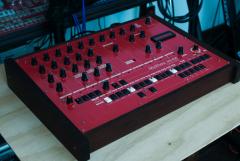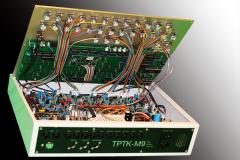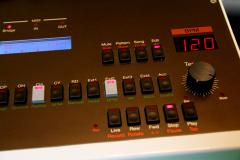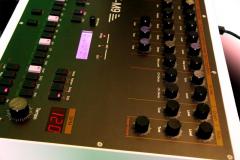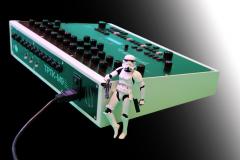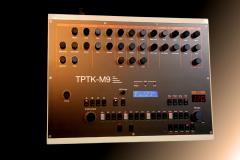-
Posts
22 -
Joined
-
Last visited
Content Type
Profiles
Forums
Blogs
Gallery
Everything posted by jamie
-
-
Hi Thorsten, just for info, if you're interested. I'm glad to say that i fixed the problem. It's in the firmware of the 9090. I tried to contact Trevor for some hints, but there was no answer to the mail i sent. But i think the mail adress i used is not actual. So i studied the TR 909 Service manual and the schematics of Trevors 9090 Drum for a long time. I figured out that the different is in the velocity signal. In the TR 909 the signal appears until a new value is set, in Trevors 9090 Drum this signal appears until a noteoff signal is received. Trevor is using some kind of Multiplexing in the velocity section. So, i was glad that i found som .asm file of his firmware in the internet. As i don't now something about programming, i was very supriesed that i found the item in this file that sets the velocity when noteoff is received. Not knowing what i'm really doing, i erased the items for the cymbal, ride and hihats sounds. Then i created a new hex-file, burned it to the pic. And: IT WORKS:-))))
-
-
-
Thank you for this hint. Changing the value in SEQ_LAYER_GetEvntL seemt to be a helping solution. I'll try this. In the meantime i also try get some solution in changing firmware on the 9090 Feedback is following. I'm using version 1.3a Best Regards, jamie
-
The MB808 and the 9090 Drum are just conected via midi (built an intern switch, so i can change to "local off" when i use this box with an DAW, or "local on" when i use it in standalone) So it's not the gatelength of the analog trigger, its more about the notelength of the midiout. It would be cool if there is a way to increase the distance between note on and note off (a little bit more legato on the open hihat, cymbal and ride section;-) Maybe adjusting this is not such as difficult? the more i think about it, the more I'm not shure if this problem could be solved on the midibox, maybe i have to ask Trevor Page if this can be fixed in the midisection on this 9090 drum board. Since this "issue" is related to the sample sounds. I think these samples should be played as one shot if they are triggered.( except the open hat, since it depends on the closed hat.) Anyway i hope there's a solution. Best Regards, Jamie
-
TPTK-M9 ?? such a strange name. But it's just a dedication to Trevor Page (TP) for creating this awesome 9090 Drum PCB and Thorsten Klose (TK) for introducing this Midibox Projekt and for his very fast helping support!! Thanks a lot. (M) for my wife for being such as patient when i spend so much time for realising this projekt And (9) for (what can i say ) another MB9090 midibox. cheers jamie
-
Hi, i already finished assembling my MB9090 (MB 808 Seq + 9090 Drum). So now, everything works fine excepting one thing: The notelenghts of the MB 808 Seq are to short for some sounds. For example the open hihats sounds cut of. If i trigger the open hihat in Live-modus and press the button as long as necessary the hitat will be played till end. Is it possibile to modify the programm, so that the outgoing midinotes get more length? jamie
-

Solved! - Problems with uploading Mios8 into PIC18F4620
jamie replied to jamie's topic in Testing/Troubleshooting
Midibox Addict thanks for your hints. I checked the PSU by connecting both (Core Modul and my own PCB) on it. PSU works fine. But now i was able to compare the PIC one on one. So i started measuring the voltage on the PICs Pin by PIn and found out, that there were some shorts on my PCB. This was caused by some signalstripes that were too close together. I fixed that by cutting this stripes an soldering some wires in. So now the PCB and the PIC works fine. THANK YOU!! -

Solved! - Problems with uploading Mios8 into PIC18F4620
jamie replied to jamie's topic in Testing/Troubleshooting
Ok, some new results: I put the pic back in another core modul, switched the power on an to my suprise it starts mios and the application. So there is no problem with the upload (what a nice result), but in the other pcb it seems that the pic won't start mios or the application. Does anyone got a clue what the possible reasons can avoid starting the application? Thanks jamie -
Hi, something strange happens when i try to upload mios into the PIC. First of all some infos. Im using a Mac with OS x 10.7.5 , Midi-Interface AMT 8 emagic (and RME Hammerfall Multiface,) Mios 1.9g, Mios Studio 2.4.2 and an own designed PCB of a mb808 sequenzer (seq dr.) The story: I burned bootloader 1.2 with MBHP Burner on the pic. then i stick the Pic into the PCB an connected the MIDI cabels to the Midi-interface. I switched on Power and started Mios Studio. The display (16X2) on the PCB shows a line of squares in the upper row. Mios detects the Core and shows: Operating Systems: Mios8 Board: MBHP_Core or similar Core Family: PIC18F Bootloader is up & running! Then i choose the Mios hex file for PIC 18F4620 and start the upload. after rebooting the Pic Mios Studio shows Operating Systems: Mios8 Board: MBHP_Core or similar Core Family: PIC18F Application is up & running! Everythings seems to be fine, but the display of the Midibox still shows a line of squares in the upper row, no "copyright" an no "ready" strings appear. If i try to uppload an application nothing happens. It's like there is no Mios uploaded. Is it Possible that Mios is running and the Display shows still this line of squares? I checked all the voltages on the Pic and the Midi connections like described in the troubleshooting for about 5 times. I also replaced the pic (3 times) but the result is always the same. I also took one Pic out of a real fine working Midibox ----> same problem. Does anyone got an idea how i can solve this? Thanks Jamie
-

Midibox and 9090 Drum Individual Accent... is there a Way to realise this
jamie replied to jamie's topic in MIDIbox SEQ
Hi Thorsten, puh, I'm still confused and have some questions to make shure that I get it right. In case of using a 9090 Board of Trevor i connect the CV Out of a SR to the Vel-In of a 9090 Instrument and i connect the trigger out of the SR to the trigger-In of a 9090 Instrument, right?. If i want two instruments to use the same CV Out, do I simply connect their Vel-In to the same CV-Out of one SR? What about the "another free of use trigger out", can I use this pin for other purposes e.g. Status LED. What about adjusting the velocity of the instruments when I programm a sequence? I simply don't know how to set the values when programming a sequence. Are incoming midinotes with different velocity values also effecting different CV Out values, too? Are you going to write some additional manual for the "dr" version? Puh, a lot of questions :(, but I have to get shure not making a mistake in my first PCB-creation Best regards Jamie -

Midibox and 9090 Drum Individual Accent... is there a Way to realise this
jamie replied to jamie's topic in MIDIbox SEQ
Hi Thorsten, are there some further progress in creating the update of the firmware ore the pcb. I'm stuck in assembling my "mb909", because the firmware and the schematic about the individual velocities (e.g. restistor network <--> shift registers) are the last pieces of puzzle i need Best regards jamie -

Midibox and 9090 Drum Individual Accent... is there a Way to realise this
jamie replied to jamie's topic in MIDIbox SEQ
Hi Jef, yeah that's right, the easiest and cheapest way is to connnect this two parts using midi. But i want to build a 909 like standalone drumsequencer. so I can use in two ways: - In studio with the daw and other equipment.(there are sometimes some pretty good results if you trigger some other instrument with patterns of the mb808) - for some live jammin acts on stage as dj.(without using a midicable as bridge between the midiout jack of the sequencer and the midi-in jack of the soundboard. And.. what can I say, but I think doing projects like this is not about saving money. It's about the feeling if you finished it an it works like you always dreamed about it. It's the harder way and I'm tellin you I really need a lot of help, but if it works .....---> "Kühbacher Weißbier" I took a look on the pics of your work. Pretty pretty nice :)!! i think you got lot of skills, so tell me why are you connecting this two board via midi an not using the trigger outs Best regards jamie -

Midibox and 9090 Drum Individual Accent... is there a Way to realise this
jamie replied to jamie's topic in MIDIbox SEQ
Hi, I almost finished creating the pcb for the MB808 sequencer. As i intend to create a all in one board i need some dokumentation of the part of the upcomming velocity controller. Are there already some schematics or sketches about the resitor network and the connection between the shift registers and the resistor network. (maybe even the connection to the 9090 boards) It would be great if I could finish the pcb in meantime, as all further hardware constructions depend on this pcb (size of the pcb -->size of the case ->frontpage, etc.) So if the new release comes out, i just have to do some adjustments of the defines. Best regards jamie -

Midibox and 9090 Drum Individual Accent... is there a Way to realise this
jamie replied to jamie's topic in MIDIbox SEQ
Whoohaaah!!! this sounds very, very, very great. So i'll wait for the new update. In the meantime i'll think about the design of the case, knobs etc. (oh, there's still enough work) Im so excited finishing this projekt and i'm lookin forward jammin with my own MB9090 :frantics: Thank you very much -
Hy, like so many others, i want to build a "MB9090", too. I already finished the 9090 Modules (Trevor rules) and i also finished the Midibox 808 (yeah TK rules too)sequencer. This two parts work fine since i connected the trigger and velocity of each sound to the Dout pins of the mb808. But i'm missing some individual dynamic variations. (not the whole velocity range, but two values e.g. accented - non accented for each sound) Is there a midibox with i can realise this (maybe seq4). If yes, what parts do i need for and how do i have to connect the soundboard with the sequencer. So if it would work with the seq4 is it possible to configure it like a mb 808 (buttons, instr. encoder, bpm, tempo encoder etc) because i like this MB808-stylish sequencer thank jamie


